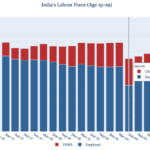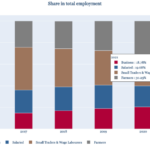What data has been telling us: The job crisis is real
Student protests in Bihar and Uttar Pradesh against the Ministry of Railways’ recruitment process have grabbed public attention in the last week. The visuals of police action against the protesting students ought to draw our attention to the root cause of student unrest, viz., the rising unemployment in the country. No wonder these protests are being called India’s “first large-scale unemployment riots”.
Data shows that over the last few years, as unemployment has risen and labour force participation has fallen, employment opportunities for India’s youth have especially worsened. In 2019, it was reported that India’s unemployment rate in 2017-18 was the worst in over four decades, according to NSSO surveys.
Throughout 2021 – CEDA’s first year in existence – we analyzed public data that demonstrated the scale of India’s unemployment crisis, especially for women and the youth. In our latest CEDA-CMIE Bulletin, we looked at changes in employment by gender over the last 5 years. In this bulletin, we are summarizing the main points from three previous CEDA publications from 2021 that highlighted the magnitude of India’s jobs crisis.
Manufacturing employment halved instead of doubling
In May 2021, the CEDA-CMIE Bulletin examined the long-term sector-wise employment in India. Using CMIE’s time-series data of sector-wise employment (Figure 1), we showed that employment in India’s manufacturing sector had nearly halved between 2016-17 and 2020-21.
Figure 1
Manufacturing accounts for nearly 17 percent of India’s economy. According to CMIE, the sector employed 51 million Indians in the year 2016-17. This declined by 46 percent to just 27.3 million in 2020-21. The importance of the manufacturing sector in generating employment and economic growth can be seen in the government launching the “Make in India” project in 2014. It sought to increase manufacturing employment to 100 million by 2022, but we are nowhere near that target yet.
CMIE data showed that all sub-sectors within manufacturing registered longer-term decline in employment. It also showed that barring agriculture, most major sectors of the industry registered decline in employment between 2016-17 and 2020-21. You can read our full analysis here.
Covid affected younger workers especially, and EPFO data proved it
CEDA published a data narrative analyzing Employees Provident Fund Organisation (EPFO) data. The law requires an organization with 20 or more employees to register with the EPFO. Thus, it serves as a proxy for formal jobs in the country.
Table 1 shows us the net payroll numbers for each age group in 2019-20 and 2020-21. It also shows us the absolute change in numbers on a year-on-year basis. We find that the youth suffered more because of the pandemic in 2020-21. Less than 18-year-olds saw a 19 percent dip in net payroll additions while 18 to 21-year-olds saw a 15.6 percent decline.
Table 1
| Age Bracket | 2019-20 | 2020-21 | Change | % Change |
|---|---|---|---|---|
| Less than 18 years | 88550 | 71701 | -16849 | -19.0% |
| 18-21 years | 2539598 | 2144384 | -395214 | -15.6% |
| 22-25 years | 2196926 | 2104166 | -92760 | -4.2% |
| 26-28 years | 882821 | 938363 | 55542 | 6.3% |
| 29-35 years | 1190687 | 1329291 | 138604 | 11.6% |
| More than 35 years | 959812 | 893261 | -66551 | -6.9% |
| Total | 7858394 | 7481166 | -377228 | -4.8% |
As we wrote, “the biggest setback of the Covid pandemic was to those age groups that are likely to be composed of first-time labor market entrants or the employed youth. The youth, despite their already high unemployment rates, as reported in the PLFS surveys, have perhaps suffered even further with a decline in formal sector jobs. The gap between their aspirations and what is available in the market only seems to have swelled up in the past year. It has set India’s younger workforce back by preventing or delaying their entry into organized employment.”
Read the data narrative here.
The youth was losing jobs even before Covid struck
The CEDA-CMIE Bulletin published in September 2021 looked at changes in employment by gender, sector, and age-group. It revealed that younger workers suffered more job losses in percentage terms in 2020-21 (over 2019-20) compared to other age-groups. Figure 2 shows the changes in average employment by age group between 2019-20 and 2020-21.
Figure 2
This CEDA-CMIE Bulletin also showed that while the young lost more jobs, the same age-groups did not see a commensurate rise in the number of unemployed but willing to work and actively looking for jobs (UEWL). This can be seen in Figure 3. This can be called the result of the discouraged worker effect which is defined as, “the decision to refrain from job search as a result of poor chances on the labour market”.
Read the full analysis here.
Figure 3
Conclusion
The manufacturing employment data shows that the sector saw biggest declines in two phases. These were between 2016-17 and 2017-18 and then between 2019-20 and 2020-21. The year 2016 saw the government demonetize currency notes of Rs 500 and Rs 1000 which affected the manufacturing sector badly. The second dip happened when the Covid-19 pandemic led to nationwide lockdowns in the country in Apr-June 2020. The decline in India’s manufacturing sector, the decline in formal employment for India’s youth and the subsequent decline in youth UEWL numbers are all indicators of the severe jobs crisis that India’s youth face.
The Indian Railways advertised 35,281 non-technical positions that attracted 1.25 crores (12.5 million) applications, which means that for every person selected, 353 applicants were not going to get a job. While the protests in Uttar Pradesh and Bihar are triggered by the changes in the Railways Recruitment Board examination shortlisting procedure, they are the manifestations of the larger anger against the lack of employment opportunities. Job creation, especially low-skilled employment, needs to be one of the primary areas of policy focus.
If you wish to republish this article or use an extract or chart, please read CEDA’s republishing guidelines.







